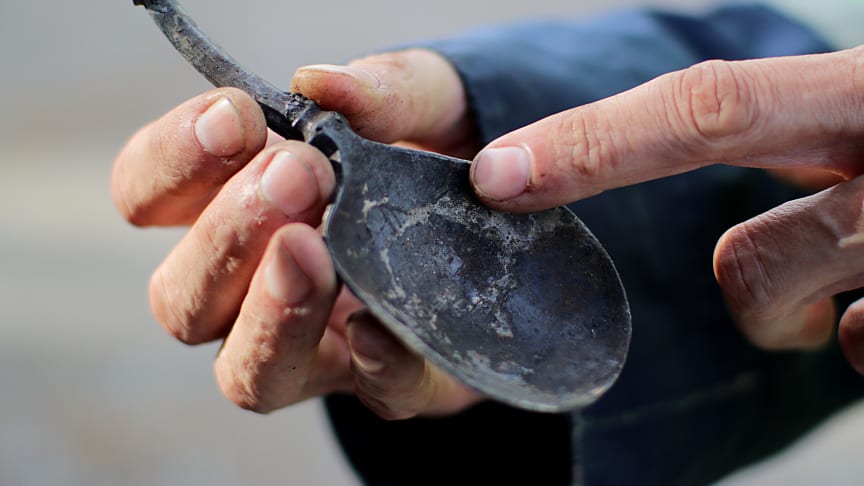Archaeological finds from Slussen at Ragn-Sells in Högbytorp

Children's leather shoes dating from the 14th century and a well-preserved clasp knife from the 17th century. These are some of the many finds that have been made by the archaeologists working on the material that has been dredged up during the work on the Slussen area – finds which in turn tell us a lot about how Stockholmers lived. The work is taking place at Ragn-Sells’ Högbytorp recycling plant, where the material is taken and processed.
The work of rebuilding Slussen in Stockholm commenced in 2016 and completion is estimated for 2025. The reason for the reconstruction is that Slussen is worn out and needs to be demolished and rebuilt from the foundations. Large quantities of material are consequently being excavated, not least from beneath the water, where the bottom is being dredged. The material from the sea bed is transported to Ran-Sells’ Högbytorp recycling plant in Bro, outside Stockholm. Three archaeologists, commissioned by Stockholm City, are periodically on site at Högbytorp to go through the extensive quantities of spoil.
”There are huge amounts of material and we are going through a few per cent here at Högbytorp, however, what we go through nevertheless tells us a lot about how Stockholmers lived,” says Björn Carlson, archaeologist at Arkeologikonsult, which is carrying out the work.
See different epochs
The dredging is being carried out right down to a depth of eight metres and digging at different levels makes it possible to see how the material is differentiated, i.e. which epoch is in which layer. The oldest is the farthest down and so on.
”What is unique about the dredged material is that it comes from beneath the surface of the water, which is an environment deficient in oxygen and which preserves all organic matter. For example, we have found leather material in the deepest layers such as children’s, young people’s and adult’s shoes dating from the 14th century, and this is the sort of material that we haven’t found much of previously”.
Björn and his colleagues have also found a lot of well-preserved wooded items, as well as glass and porcelain, which just like leather helps to date the spoil.
”We have found numerous clay pipes, which was how people smoked tobacco. They have different appearances during different phases, which helps us to date them fairly accurately. We are also looking at everyday life and what type of table culture was practised by looking at ceramic finds such as plates. As the people were not literate, personal possessions were marked by engraving an owner's mark”.
Numerous finds from the train oil huts
The bulk of the dredged material that the archaeologists at Högbytorp are going through is from the 16th and 17th centuries. At that time the train oil huts were situated where McDonalds is currently located and many of the finds can be derived from them.
”Seal oil, half-rotten seal fat which is boiled in large pots, was processed in the train oil huts. It smelled disgusting and was therefore sited outside the city, which at that time was Södermalm, and the smell of tar is still present in the material”.
”The train-oil works produced fuel for train-oil lamps, so that Stockholmers had lighting during the winter darkness. Light was needed in order to perform important handicrafts and other tasks during the evening”.
The archaeologists have made finds such as seal penises, barrels and tools from the train oil huts. The material also contains numerous remnants from animals other than seals, indicating that there were lots of animals on Södermalm at that time.
“Animal bones enable us to see traces of slaughtering, which tells us something about how and what was eaten. At the macro level, experts can help us to look into the soil and analyse what grains and other types of food were eaten and which parasites were present in, for example, dung. This can be added to from various sources to obtain a fairly clear picture of how Stockholmers lived,” Björn Carlson says.
Will become a popular science book
The archaeological work is taking place intermittently during the work on the new construction of Slussen.
”What we are obtaining from the dredging spoil is an excellent complement to the archaeology on the shore, as the organic matter can be collected in a completely different way”.
The overall picture of Slussen’s history is emerging little by little and many of the finds that have been found and the conclusions that are drawn will be available to the public.
”The really good finds are posted up on the ”Slussenportalen“ archaeology page and some then end up in the Museum of Medieval Stockholm so that everybody has the chance to see them. We will be writing a report about this and the aim is also that it will be in the form of a popular science book, not just an academic report”.
About Ragn-Sells Group
The Ragn-Sells Group is a privately held corporate group, operating companies in four countries.